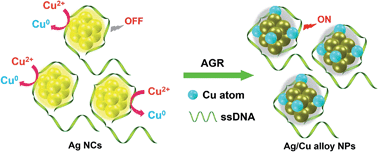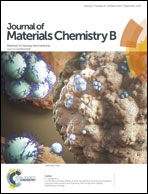A novel biosensor for copper(ii) ions based on turn-on resonance light scattering of ssDNA templated silver nanoclusters†
Abstract
A new ultrasensitive biosensor for copper(II) ions was developed based on turn-on resonance light scattering (RLS) of ssDNA templated silver nanoclusters through anti-galvanic reduction (AGR). In our experimental assay, ultra-small size fluorescent C-rich ssDNA templated silver nanoclusters (C-rich ssDNA–Ag NCs) exhibit direct reduction of copper(II) ions to elemental copper (Cu0) and the resulting Cu0 formed copper nanoparticles on the surface of C-rich ssDNA–Ag NCs spontaneously. The process produced Ag/Cu alloy nanoparticles with larger diameters, turning-on RLS signal of C-rich ssDNA–Ag NCs. As the concentration of Cu2+ ions increased, the RLS signal of C-rich ssDNA–Ag NCs gradually enhanced. The present method achieves the detection of Cu2+ ions in a linear range of 5 × 10−9 M to 7.5 × 10−7 M with a detection limit of 2 nM. Moreover, RLS spectrum, TEM image, fluorescence spectrum, X-ray photoelectron spectroscopy (XPS), and MALDI-TOF mass spectrometry were carried out for investigating the mechanism of the biosensor. The present strategy of constructing a biosensor based on AGR of metal nanoclusters paves a new way to design novel RLS probes.


 Please wait while we load your content...
Please wait while we load your content...